
Dry Steam
Finding a Niche in the Nooks and Crannies
By Kathy Danforth / Published June 2019
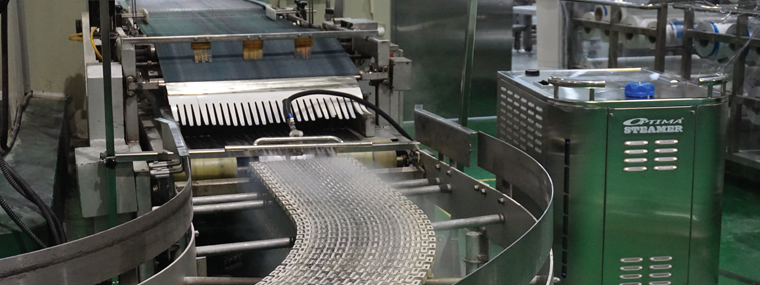
Pressure washing offers a wide range of pressures, flows, additives, temperatures, and even cleaning media, with these variations providing diverse options for the unique, dirty surfaces awaiting. What efficiently cleans one substrate may destroy another, so part of the pressure cleaning job is making the “matchless match” between machine and material. Dry steam offers a combination of low pressure, deep penetration, and sanitization that makes it particularly suited for delicate, hard-to-reach surfaces, particularly if they need to be sanitary as well as generally uncontaminated.
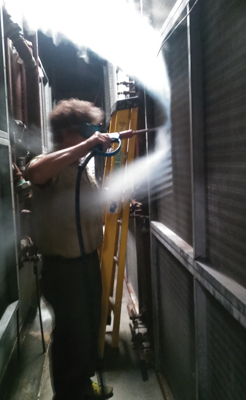
University of Louisville Hospital coil cleaning.
Yujin Anderson with Steamericas, which expanded its operations to Los Angeles from South Korea in 2010, shares, “Cleaning HVAC coils is a new application in the sense that dry steam has not been used. Traditionally, coils have been cleaned with foaming agents and water. The issue is that the coils are typically a few inches to a few feet thick and are intertwined, so when you shoot water at them, the water splashes back. AC handlers or HVAC systems are typically indoors, so you can’t use a lot of water. The coils are delicate and can’t withstand high psi. With a foaming chemical and low psi, there is also a lot of manual effort in cleaning, and you can’t guarantee that the water or foam is getting all the way through.
“On the other hand,” explains Anderson, “steam—a gas—can be seen coming through the coils. It sanitizes, since the temperature is at least 212°F and may be up to 300°F. That’s hot enough to kill mold and bacteria; the effect of the heat replaces the chemicals. The psi is 100–125, which is low enough to avoid damaging coils but high enough to push the gas through.”
Dry steam, also known as “wet heat,” has different characteristics than either wet steam or dry heat. “Wet steamers are low-flow, hot-water pressure washers,” says Anderson. “Their flow is in gpm, while the flow rate of our dry steamer is .08 gpm. Most of the water evaporates, so there is not usually run-off. If it is used continuously in one spot, there might be a need for wiping or a wet-vac occasionally, but that is rare,” she notes.
“Dry steam is safer than a hot water pressure washer because the psi of dry heat is so low,” explains Anderson. “As soon as it exits from the nozzle, the psi drops significantly; six to eight inches from the nozzle, it won’t burn because the temperature and pressure have dropped. Hot water also holds the heat much longer. However, the accessories for a dry steamer can become hot enough to cause a burn.”
Whether a steam cleaner will be faster varies depending on the particular job, but for HVAC applications, Anderson advises that it is not slower than traditional cleaning. “Steam doesn’t cover as wide an area—with its limited water flow, it’s a good fit for more detailed work, such as HVAC systems, indoor work, or outdoor work if you have to capture the wastewater. For example, if you have to place a collection mat or have to tarp an area for a job, the preparation can take longer than the job. Then you may have to carry off the recovery tank and dispose of the water. Cleaning may take longer, but setup is quicker and there is no wastewater mat or collection. Steam is a one step process, whereas pressure washing may take up to three steps. Dry steam is also advantageous if there is no water source, and it can bypass chemical use and the need for a variety of tools. Some contractors are wary of using chemicals because they shorten the lifespan of the coil due to corrosion. Also, people are sensitive to chemical residues in the air, so facilities and contractors are looking for an eco-friendly solution. However,” Anderson points out, “the main issue with HVAC coils is that with a pressure washer, there is splashback, and the high psi will damage the coils.”
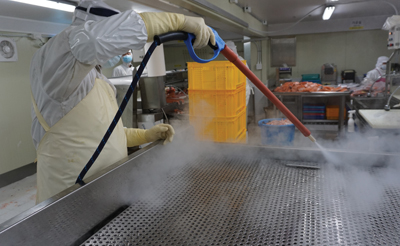
Steam cleaning a fish factory.
Another industry situation where dry steam cleaning is optimum is food production. Again, water splashback plays a role in keeping water from reaching all areas. “In a large food plant, the equipment is tented, and thermometers are placed at different locations to monitor that all reach 212°F,” says Anderson. “The dry steam can carry heat, penetrate, and sanitize better than dry heat.”
Anderson relates that steam cleaning can enable more CIP (cleaning in place) as opposed to COP (cleaning out of place), resulting in time savings. “At one company a huge salad mixer had to be sanitized daily. They used to take the pieces apart, pressure wash it outside, rinse and dry the parts, and reassemble it. Now, it is entirely tented and cleaned in place.”
Conveyor belts in food processing facilities are a common cleaning challenge with hard-to-reach areas. “Dry steam can clean between the wires and in other inaccessible parts,” relates Anderson.
“I want to emphasize that steam can be part of wet cleaning or controlled cleaning, but it doesn’t replace dry cleaning,” says Anderson. “Dry cleaning removes visible material, possibly with a vacuum or broom. Wet cleaning can be done with dry steam, as can controlled cleaning. But you cannot skip dry cleaning before dry steam cleaning—steam is not for removing big chunks. That would be comparable to steam cleaning a carpet without vacuuming it first.”
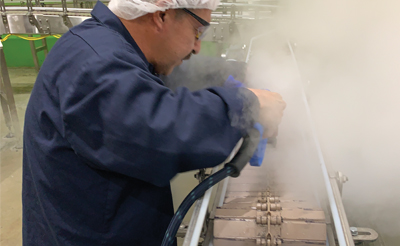
The focus on pervasive cleanliness has been intensified recently by the force of law. “The Food Safety Modernization Act went fully into effect in early 2019,” reports Anderson. “This widened the scope to all types of food, even pet food, and all sizes of companies involved in manufacturing, packaging, warehousing, or transporting food. The areas which are swabbed for bacteria were expanded to include surfaces which do not have contact with food as well as the traditional food contact preparation surfaces. Now companies have to swab floors, the bottom of conveyors, and even drains.”
Since bacteria thrive in moist environments, this heightened cleanliness standard provides extra impetus to use dry steam for cleaning. Anderson observes, “Pathogens live in moist areas where food doesn’t touch, but then they make their way up to a conveyor or place they shouldn’t be.” With water implicated as a prime contributing factor in bacterial growth, companies want to eliminate it when possible. Anderson adds, “Now many plants and kitchens want a ‘dry clean facility’ with a dry floor at all times. In striving for ‘dry clean facilities,’ dry steam helps because it eliminates the need for a drain entirely,” explains Anderson. “Some-times a facility doesn’t need better sanitization; they want to get rid of the headache of drains and keeping them clean.”
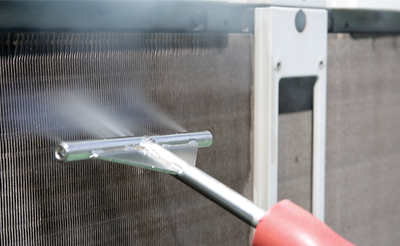 In the quest for reducing contamination in food production facilities, Anderson notes that dry steam’s role is usually to sanitize. “General cleaning gets the surface clean, but sanitizing is getting the bacteria count reduced to an acceptable level. Sterilizing is getting the bacteria count to zero, which dry steam can do, but that requires a very controlled environment like an autoclave, and protocols have to be followed exactly. In general use, dry steam sanitizes.”
In the quest for reducing contamination in food production facilities, Anderson notes that dry steam’s role is usually to sanitize. “General cleaning gets the surface clean, but sanitizing is getting the bacteria count reduced to an acceptable level. Sterilizing is getting the bacteria count to zero, which dry steam can do, but that requires a very controlled environment like an autoclave, and protocols have to be followed exactly. In general use, dry steam sanitizes.”
While the high heat kills pathogens, the temperature is not usually a problem for the materials being cleaned. “Industrial equipment is pretty heat resistant,” Anderson observes. “Occasionally there may be an issue with automotive radio equipment or electrical components. With very sensitive electronic components, steam should not be kept directly pointed at the same spot.”
Less chemicals, less water and run-off, and less project time, but more penetrating and thorough cleaning—dry steam provides an important tool for those hard-to-solve, hard-to-reach cleaning situations.





